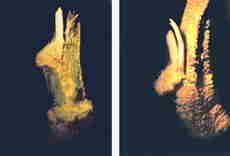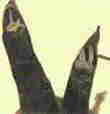|

Fig.2. Left:
side view of the spiniferous areole. Right: its longitudinal
cross-section.

Fig. 3. Tubercle apices with
spines
|
|
Many plants grow at both sites, of the
order of 20 plants per square meter in some individual colonies.
Scarcely any undamaged plants were found, as they are the victims
of the destructive feet of grazing goats The neighboring cactus
populations include A. retusus, Coryphantha
bergeriana, C. palmeri, Echinocactus
platyacanthus, Ferocactus pilosus,
Mammillaria candida, M.
chionocephala, M. compressa,
Myrtillocactus geometrizans, Opuntia
imbricata, O. leptocaulis, O.
stenopetala, O. tunicata and
Thelocactus tulensis.
The A. agavoides plants at
the new locations are characterized by the presence of spines on
each tubercle. As a rarity, this phenomenon is not unknown; Ted
Anderson, now at the Desert Botanical Garden in Phoenix, took
photographs of such a plant found by him, the only one seen at an
A. agavoides site near Tula, Tamaulipas, in
1960.
The new locations widely extend the
distribution of A. agavoides by about 50 km and
substantially reduce the threatened status of this species. The
known sites now number six. The discoverers choose to withhold
location details to provide a measure of protection from illegal
collectors.
Photos: Fig. 1 by M. Sotomayor: rest by the
authors
|